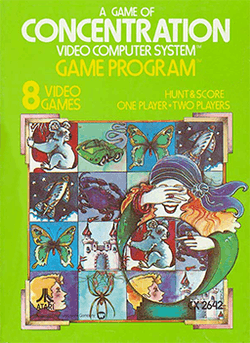A Game of Concentration
| A Game of Concentration | |
|---|---|
 | |
| Developer(s) | Atari |
| Publisher(s) | Atari |
| Designer(s) | Jim Huether |
| Platform(s) | Atari 2600 |
| Release | |
| Genre(s) | Concentration |
| Mode(s) | Single-player, multiplayer |
A Game of Concentration (also known simply as Concentration and Hunt & Score) is a video game produced by Atari, Inc. and released in 1978 for its Atari 2600 video game system.[1] The game was programmed by Jim Huether,[2] and is a video version of the classic memory game. It was one of a handful of games that used Atari's keypad controllers.[3]
Gameplay
The game is played using a matrix of numbered panels, either 4 x 4 (for 16 panels) or 5 x 6 (for 30 panels). Using the keypad, players enter the number of the panels they wish to reveal. If the images behind the two panels match, the panels are removed and the player scores 1 or 2 points, depending on what difficulty the switch is set to, along with an extra turn.[4]
The game has a total of eight variations, four each for each matrix size and four have wild cards. Each matrix can be played by either a single player or by two players taking turns; in single-player games, the player attempts to clear the matrix with as few incorrect matches as possible. Also, players can enable wild cards that will match any image on the board.[5]
Ports
Concentration was also released by Sears for its private-label version of the Atari 2600, the "Sears Video Arcade," under the name Memory Match.[6] In August 2010, Microsoft announced plans to re-release the game for its Game Room service on the Xbox 360 and on Games for Windows Live.
References
- ↑ "Concentration for Atari 2600". GameFAQs. Retrieved 2010-08-26.
- ↑ "Game of Concentration (Atari)". AtariAge.com. Retrieved 2010-08-26.
- ↑ "Atari Keypad". AtariAge.com. Retrieved 2010-08-26.
- ↑ "Atari 2600 Manuals - Game of Concentration (Atari)". AtariAge.com. Retrieved 2010-08-26.
- ↑ "Atari 2600 Manuals - Game of Concentration (Atari)". AtariAge.com. Retrieved 2010-08-26.
- ↑ "Memory Match (Sears)". AtariAge.com. Retrieved 2010-08-26.
External links
- A Game of Concentration at AtariAge
- A Game of Concentration at GameFAQs